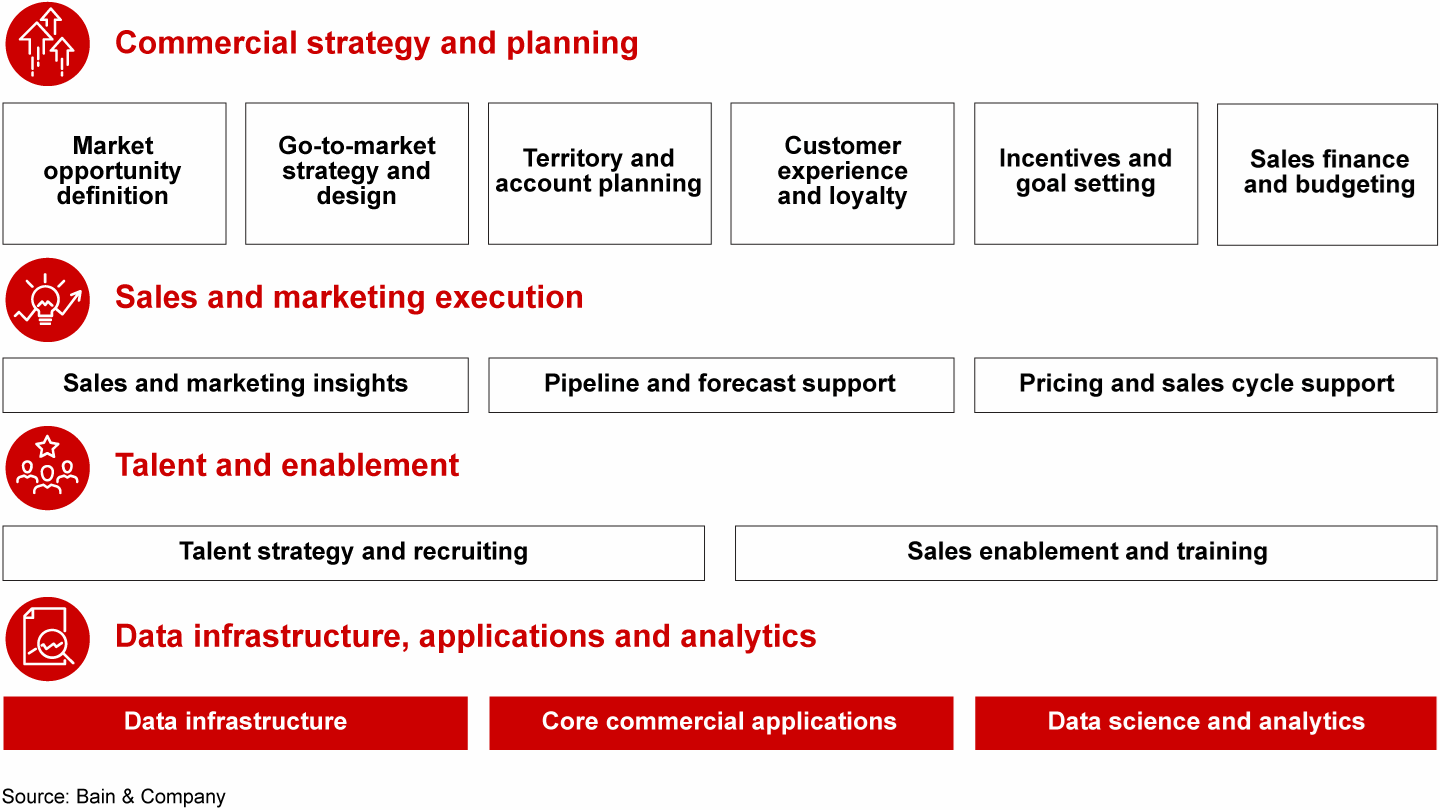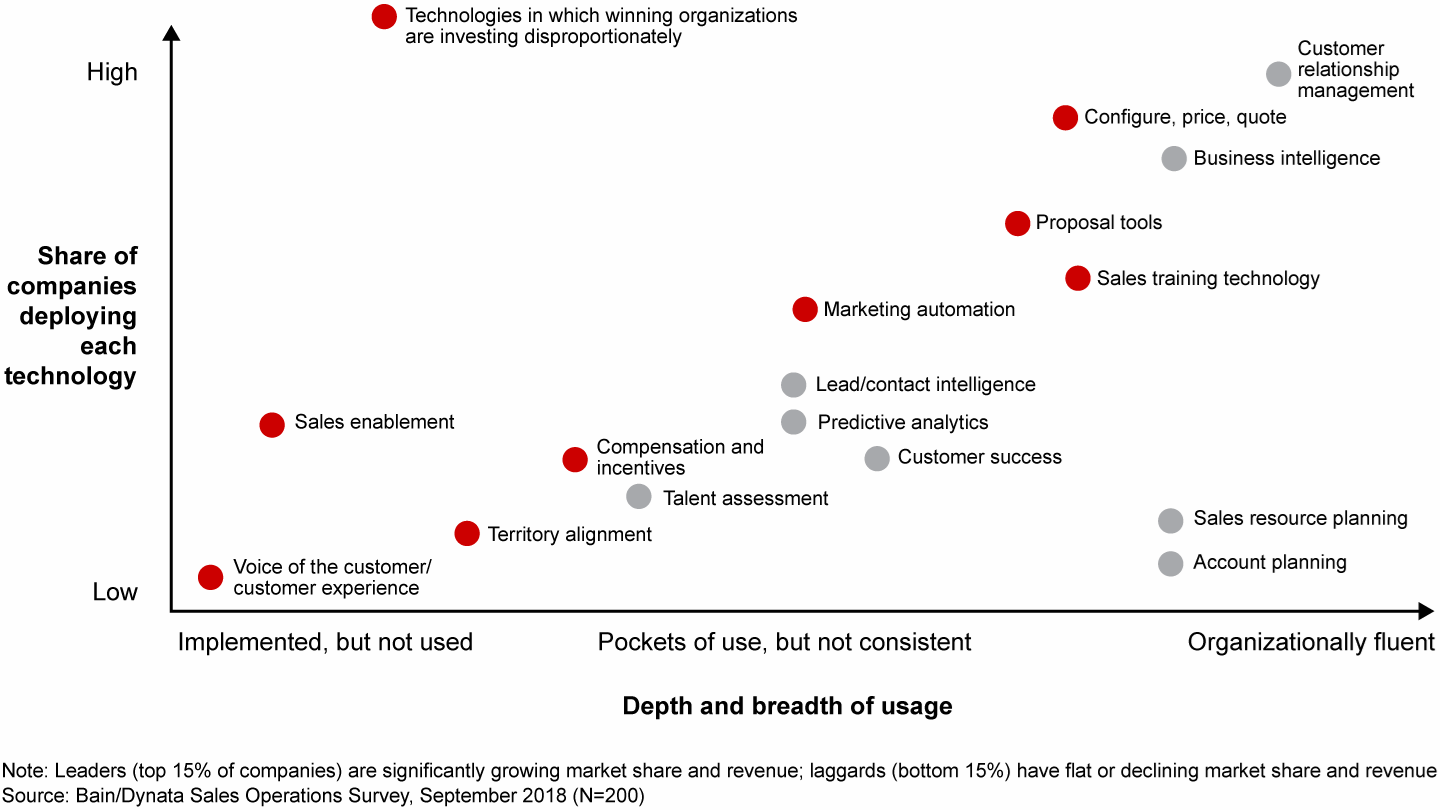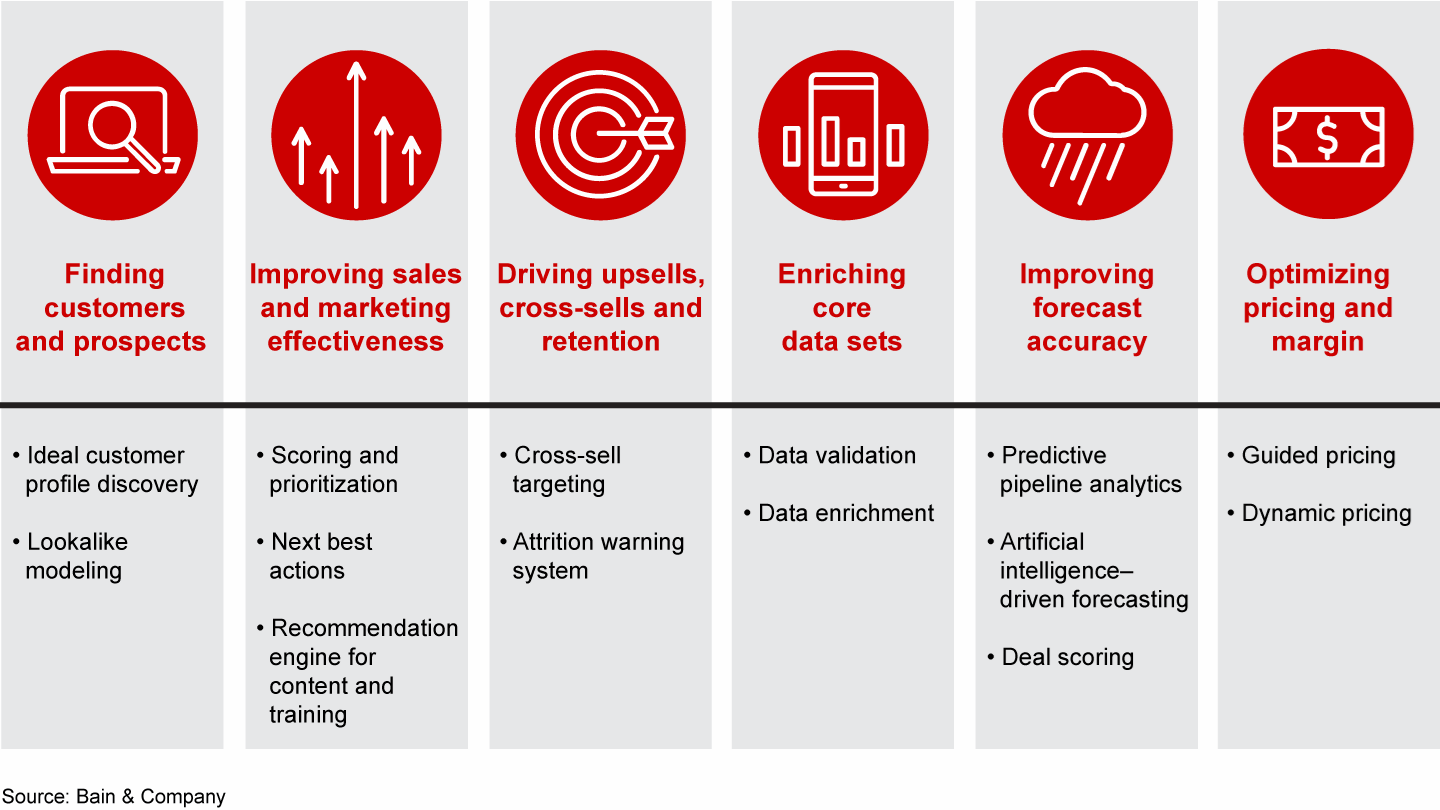Etude

En Bref
- Successful sales efforts today hinge on a mastery of digital tools—especially digital infrastructure, applications and data analytics.
- Bain’s survey finds that high-growth companies build more effective data and analytics capabilities and that they deploy 25% more digital tools with wider adoption than low-growth companies.
- The leading companies are twice as likely to maintain a best-in-class digital infrastructure.
- Their commercial operations groups have shifted their focus from tracking selling and pipeline activity to reducing the administrative burden on the front line and empowering reps to sell more effectively.
Sales performance management tools have proliferated (more than 7,000 sales and marketing software applications by one recent count) to the point at which sales organizations struggle to separate the hype from proven value. Too many sales organizations go full steam ahead, acquiring good tools only to find that they haven’t built the infrastructure to wring out the tools’ value. Or worse, companies assemble tracking tools that increase the administrative burden on sales representatives, forcing them to spend less time in front of their customers. On the flip side, some sales organizations that are skeptical of new tools miss the opportunity to deploy their sales teams more efficiently at higher-quality prospects.
This predicament is more than an annoyance. Successful sales efforts today hinge on digital tools—maintaining a robust digital infrastructure, deploying the right applications and mining digital data to bring insights to the field are all crucial ingredients. High-performing sales organizations supported by strong “commercial operations” teams (sales operations teams with a broader, more strategic mandate) excel in using digital technologies and often function as the stewards and power users of these technologies.
Bain & Company and Dynata research on 200 business-to-business (B2B) companies in the US, combined with our experience working with hundreds of sales organizations, find that 14 capabilities underpin the commercial operations group (see Figure 1). Furthermore, the leading companies (defined as the top 15% in revenue and market share growth over the past two years) build and maintain more effective data and analytics capabilities, and they deploy 25% more digital tools with wider adoption than the laggard companies (defined as the bottom 15% in revenue and market share growth over the past two years) do. Let’s look at those digital capabilities in more detail.
These 14 capabilities underpin sales and marketing effectiveness


Data infrastructure
The leading companies are twice as likely to maintain a best-in-class digital infrastructure (the architecture and management of core customer, sales and market data) relative to companies with flat revenue and market share. Leaders have deliberately avoided storing customer and prospect data in multiple places because data silos impede data flow and reliability—especially when a company is trying to use advanced analytics. One medical technology company dealt with this problem by creating a master data management team to oversee customer data quality, stewardship and use by the commercial organization. Having a dedicated team laid the foundation for the company to make better use of its data.

Empowering Sales Teams with Smart Digital Tools
Successful sales efforts hinge on state-of-the-art digital solutions. Here's how leading organizations make the most of them.
Core commercial applications
Leaders are also twice as likely to curate a best-in-class digital application stack, which is built around bedrock systems, such as customer relationship management (CRM) systems, business intelligence tools and marketing automation platforms. When combined with the improved data infrastructure, a smart deployment of digital tools contributes to higher margin and share growth.
While well intentioned, the trend of tracking selling and pipeline activity in ever-greater detail has gone too far in many cases, and leading organizations are now trying to simplify and automate the mountain of call logs, account status updates, sales forecasts and other administrative activities that burden the salesforce. They focus disproportionately more on deploying tools that help sales representatives—including configure, price, quote platforms; advanced proposal tools; and sales training technology. Many of these tools help to increase win rates or to free up reps from administrative tasks so that they can spend more time selling.
One technology company, for instance, launched new coaching and sales enablement platforms, including a digital knowledge management system (as part of its CRM) to prescribe the next best actions for reps. Digital market mapping prioritized where to deploy resources to ensure that the salesforce targeted the highest-value customer. A digital account planning tool focused account teams on the highest-priority actions. As a result, the company expanded the time that reps spend actually selling by roughly half, improved the overall win rate by about 60% and almost halved the ramp-up time for new hires.
By contrast, the laggards focus more on maximizing their use of CRM because they are still trying to bring their core commercial applications up to an acceptable level (see Figure 2).
Laggard organizations are trying to raise their data infrastructure to an acceptable level, while winners focus on empowering the front line


Another point of distinction is that, after adopting a digital tool, leaders devote sufficient resources toward reinforcing how to use it effectively. Companies too often give short shrift to the extended process of adoption, which is why they don’t get the full value out of their digital investments.
Data science and analytics
Leading commercial operations groups are bringing big data to bear in solving sales and marketing challenges. They’re using advanced analytics in endeavors such as finding the ideal customers and prospects and increasing cross-selling of the right products (see Figure 3). And when the data science and analytics conjoin with sound data infrastructure and the right technology applications, companies can substantially boost sales productivity.
Advanced analytics has raised productivity in numerous aspects of sales and marketing


One B2B technology company uses advanced analytics to define its ideal customer profile, prioritize specific accounts and align selling resources accordingly. Besides the basic criteria, such as customer revenue and headcount, the organization developed a predictive model that looked for businesses showing accelerated hiring of specific roles that served as a reliable indicator of demand for the company’s core product offerings. The company also incorporated variables that indicate a higher willingness to purchase, such as changes in key leadership roles that typically made the purchasing decisions. Using this data, the company now can deploy sales reps to the highest-priority opportunities while also guiding them on which products to offer.
Software and digital tools have become indispensable to sales organizations. High-growth companies use more digital tools, and use them more effectively, often thanks to a strong commercial operations team that promotes the adoption of digital tools. The best commercial operations teams focus less on tracking and more on building the digital infrastructure that yields insights and on investing in tools that reduce the administrative burden on the front line, empowering those reps to become more effective.
Chris Dent is a principal, Greg Callahan is a partner and Joost Vasters is a principal with Bain & Company’s Customer Strategy & Marketing practice. They are based, respectively, in Chicago, Boston and Amsterdam.
About Dynata
Dynata is one of the world’s leading providers of first-party data contributed by consumers and business professionals. With a reach that encompasses 60+ million people globally and an extensive library of individual profile attributes collected through surveys, Dynata provides precise, trustworthy quality data. The company has built innovative data services and solutions around this core asset to bring the voice of the individual to the entire marketing spectrum, from market research to marketing and advertising. Dynata serves nearly 6,000 market research agencies, media and advertising agencies, consulting & investment firms and healthcare and corporate customers in the North America, South America, Europe, and Asia-Pacific. For more information, go to www.dynata.com.